
Features
Environmental Control
Structures & Equipment
Out of this world
March 2, 2011 By Treena Hein
Research on hydroponics in space might seem like it has little to do
with greenhouse production here on Earth, but the work of Dr. Mike Dixon
and his colleagues has already led to commercialized products – and
more technologies for earthbound greenhouse operators are in the works.
Research on hydroponics in space might seem like it has little to do with greenhouse production here on Earth, but the work of Dr. Mike Dixon and his colleagues has already led to commercialized products – and more technologies for earthbound greenhouse operators are in the works.
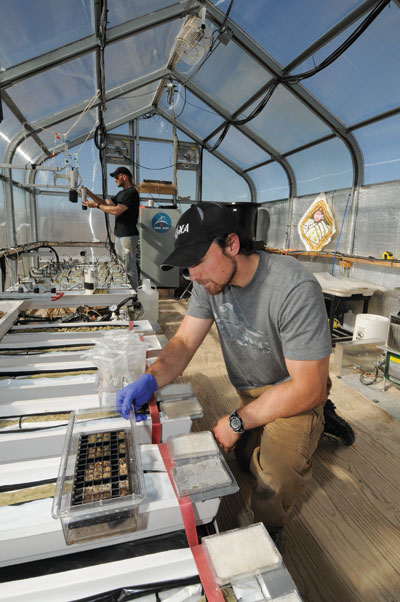 |
|
| Researchers Matt Bamsey (foreground) and Thomas Graham with Enviro-Grow medium field trials. PHOTOS COURTESY UNIVERSITY OF GUELPH Advertisement
|
As a professor in the University of Guelph’s School of Environmental Sciences, Dixon has spent many years studying various aspects of hydroponics and sealed growing chambers in the school’s “Controlled Environment Systems Research Facility” (CESRF).
“My research mostly involves collaborating with NASA’s Mars Greenhouse Project to create engineering criteria for greenhouses in vacuum, experimenting with recyclable growth media and developing nutrient management sensor technology,” Dixon says. He and his colleagues use lettuce and radishes because they grow quickly, but the team has a long list of other crops they plan to study as well.
SPACE TRAVEL RESEARCH HAS DOWN-TO-EARTH BENEFITS
The next major international effort in space is the exploration of Mars or the moon, notes Dixon, a fact that has opened up two-way technology transfer for growing plants in sealed environments.
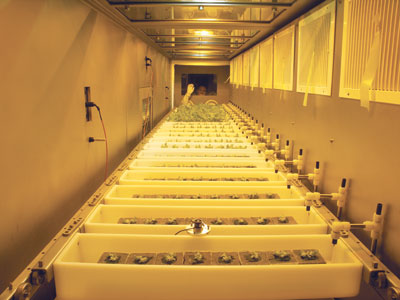 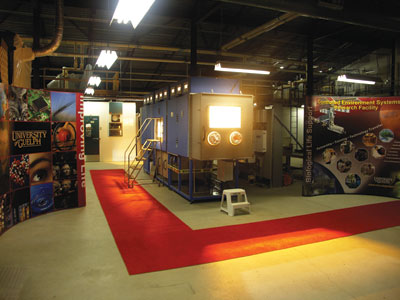 |
|
| These are interior and exterior views of the sealed environment chamber, developed in Guelph, and delivered to the MELISSA Pilot Plant in Barcelona. PHOTOS COURTESY UNIVERSITY OF GUELPH |
“Long-term exploration missions must include plants since you want to be mostly self-sustaining rather than being dependent on constant re-supply of resources,” says Dixon. “Higher plants provide many of the functions for human life support in closed systems including food, fixation of CO2, production of O2 and transpiration of fresh water.”
Dixon observes that the Canadian greenhouse industry has developed considerable innovative technology to combat the environmental challenges of food production in Canadian winters, and these sealed environments are a logical technical backdrop in researching the even stricter environment control challenges involved in space exploration.
“Moreover,” he says, “the refined technologies developed for space environments can be used here on Earth as well. It’s a two-way street.”
CESRF is also Canada’s contribution to the Micro Ecological Life Support System Alternative (MELiSSA), an international effort to study food production and atmosphere management, spearheaded by the European Space Agency. “We designed, built and tested a sealed environment chamber that was delivered to the MELISSA Pilot Plant in Barcelona, Spain, in late 2009, and it’s being used in continued research activities,” says Dixon. “The waste streams feed the food production as part of an enclosed life support loop.”
IMPORTANCE OF SENSORS IN HYDROPONIC SYSTEMS
“In space, there is the requirement for having to recycle everything, and that means absolutely everything,” says Dixon. Properly recycling nutrients in controlled environment plant production, however, requires sensors that accurately monitor water quality.
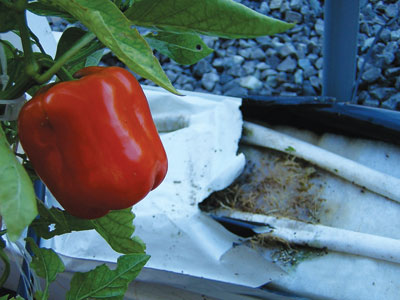 |
|
| A recyclable hydroponic substrate made from plastic, recently commercialized by SRI Petro Chemical Division (Waterloo, Ont.), won the 2007 Ontario Centres of Excellence “Mind to Market Award.” PHOTOS COURTESY SRI |
“Currently, pH and electrical conductivity sensors are all we have,” Dixon notes. “Plants influence the quality of a nutrient solution as they grow, and the longer a nutrient solution is used, the more difficult it is to get a handle on what’s in there. Keeping a grasp on nutrient concentrations is the bane of hydroponic cultivation, not to mention water-borne pathogens. Right now, growers have to sample – and dump it if it’s off, starting over with new solution – often proper adjustments are impossible.”
Dixon says the greenhouse industry has been among the most proactive in terms of minimizing environmental impact, “but the ability of operators to do that can be even greater with better sensor technologies.”
It’s been a long road to create sensors able to measure all the ions in the solution, from nitrate and phosphate to potassium and micronutrients. “We’ve been at it 10 years, and tried many approaches,” Dixon notes. “We’ve had many international industry partners, and a lot of failures.”
PROMISING NEW TECHNOLOGY ‘AN ENORMOUS TECHNICAL LEAP’
However, he and his graduate student Matt Bamsey, co-supervised by Dr. Alain Berinstain of the Canadian Space Agency, and working in collaboration with University of Ottawa chemistry professor Juan Cesar “Tito” Scaiano, have developed a new system that is proving to be a winner. “We’re having great success with technology that measures the optical properties of the solution to determine the concentration of ions,” Dixon says. “The research also involves COM DEV Canada (a major player in the international satellite industry, based in Cambridge, Ont.) and the National Optics Institute in Quebec City. This is an enormous technical leap, and we’re confident that this will work.”
Beyond greenhouse industry use, Dixon is sure this sensor technology will have many applications in medical and industrial chemistry fields. “We’ve submitted proposals for hardware and software development of the technology,” he says, “and we’ll be testing in commercial greenhouses and in space in the relatively near future.”
RECYCLABLE HYDROPONIC SUBSTRATE NOW IN COMMERCIAL GREENHOUSES
Another example of the technologies Dixon and his colleagues have helped develop for space that are available for use in the commercial greenhouse sector is a recyclable hydroponic substrate made of plastic called Enviro-Grow. Recently commercialized by SRI Petro Chemical Division (Waterloo, Ont.), the product won the 2007 Ontario Centres of Excellence “Mind to Market Award.”
Different refinements to the product are being developed for green roof applications, aquaponic strawberry production and hydroponic lettuce, micro-greens and sprout production. The company recommends replacement of the medium after five cucumber crop cycles and after every second crop for peppers and tomatoes.
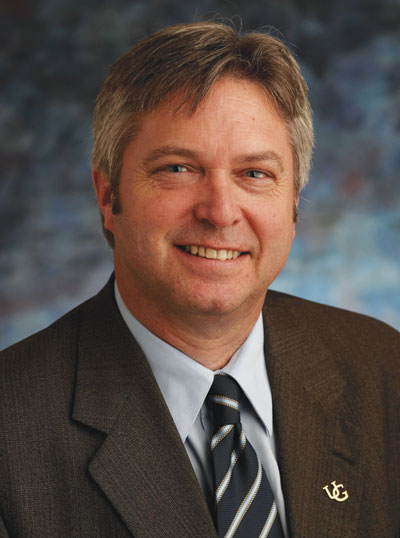
|
|
| Dr. Mike Dixon. PHOTOS COURTESY UNIVERSITY OF GUELPH |
“We studied how best to use the medium,” says Dixon, “and as with any medium, there are best practices, but most importantly, we found overall that plants grown using the system had better or comparable fruit yield than that of plants grown on conventional media such as rockwool.”
The research program is also working on a substrate that is biodegradable.
Dixon is also collaborating with Guelph-based Purification Research Technologies Inc. on a system that controls the dissolution of ozone, used for continual disinfection in hydroponic operations. “It leaves no toxic residue behind after it interacts with organic molecules in the nutrient reservoir or in the fertilizer distribution system,” says Dixon. “This technology also has the potential to be used beyond the agri-food sector in food safety applications.”
For more information:Controlled Environment Systems Research Facility –
Treena Hein is a freelance writer and photographer in Ontario.
Print this page